Skull
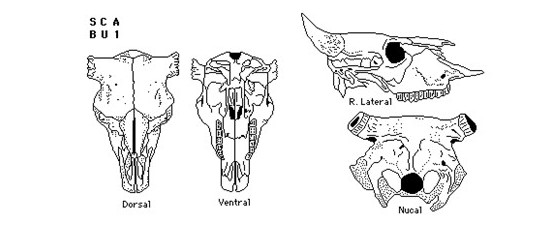
Although in reality the skull contains a number of individual bones, it is considered here as though it represents a single element. The presence or absence and condition of the maxillary dentition is always coded as being weathered; BU for loose maxillary teeth is coded as indeterminate.
For the Oldman Dam Project, certain cranial portions analyzed separately by Bone Unit are coded as left and right although the skull as a unit is generally considered axial. Example would be the maxillas, nasals, etc.
For the Oldman Dam Project, cranial fragments of indeterminate location are coded as undifferentiated BU. For materials recovered in 1988 as part of the Oldman Dam project, EMA coded only horn core tips as BU-6. Other pieces of horn core were coded as “horn” BU undifferentiated. This was not done in subsequent years of the program by EMA or by other investigators.
For the Fincastle Project, Bone Units 35 (previously undefined in the 1991 edition) and 43-46 were added.'), ('Mandible', 'The presence or absence and condition of teeth are ignored for the purpose of bone unit analysis. For the Oldman Dam Project, the condition of loose mandibular dentition is coded as weathered, and bone unit for loose teeth is coded as indeterminate.
For the Fincastle Project, Bone Units 51-52 were added.
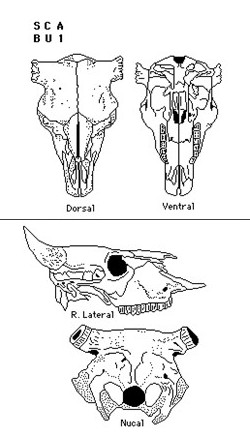
BU 1
SC A
Complete element. Dentition may or may not be complete.
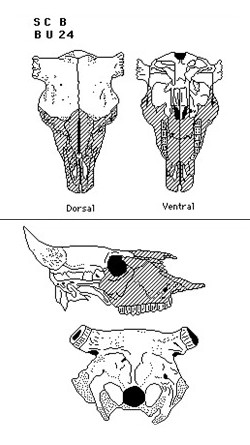
BU 24
SC B
Unit consists of essentially complete posterior portion of skull from which nasals, premaxilla, maxilla, malar, lacrimal and palatine have been removed. Brain cavity intact. Horn cores intact.
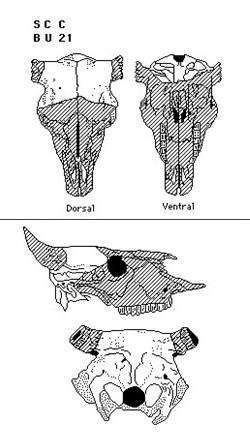
BU 21
SC C
Unit consists of: essentially complete occipital; all or most of left and right internal and external auditory meatii; squamous portions of temporals minus zygomatic processes and condyles of the temporals; all or most of both parietals. Posterior portion of frontals intact but medial and anterior portion smashed allowing access to brain cavity. Both horn cores removed completely or near base. Temporal and orbital portions of frontal may or may not be present.
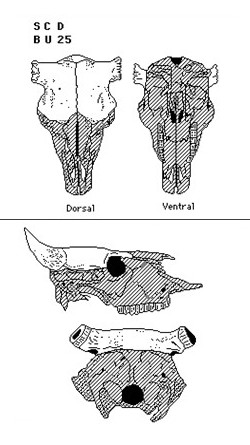
BU 25
SC D
Unit consists of both intact horn cores and both intact articulated frontals. Virtually all of occipital and other portions of skull absent. In some instances anterior margins of frontal may be absent.
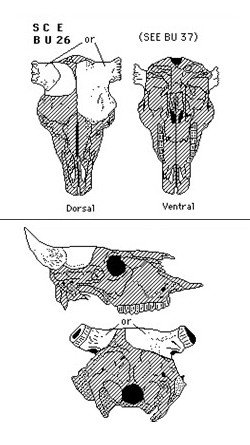
BU 26
SC E
Consists of one intact horn core and all or moderately large portion of frontal. SC D (BU 26) is essentially one half of SC B (BU 25). Frequency indicates number of crania represented. Similar to BU 37.
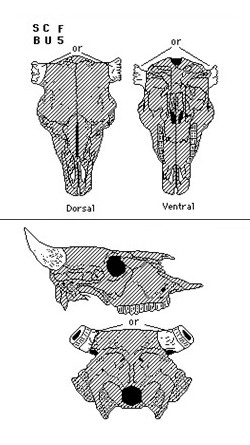
BU 5
SC F
Essentially complete horn detached from the rest of the skull.
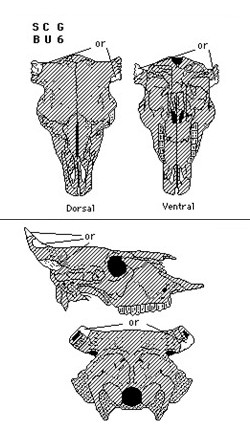
BU 6
SC G
Fragment(s) of shattered horn core. Frequency should indicate the minimum number of horn cores represented regardless of the number of fragments present. For Oldman Dam, frequency indicates number of fragments only.
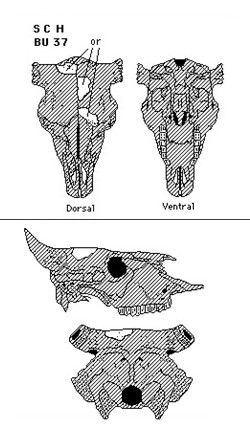
BU 37
SC H
Small to large fragment of frontal bone. No horn core portion present. Orbital portion of frontal not represented. Similar to BU 26, BU 35. (DS)
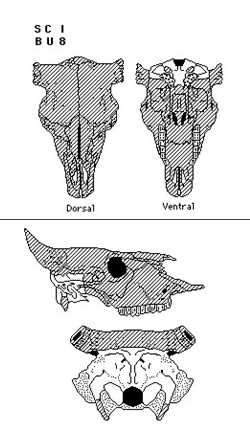
BU 8
SC I
Consists of occipital condyles including the occipital condyles, basilar part of occipital, and the basilar tubercules; all or most of the internal and external auditory meatus; most of parietal and squamous temporal bones. Paramastoid processes have been removed and the bulla tympanica crushed.
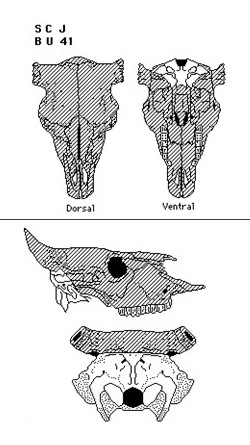
BU 41
SC J
Unit consists of occipital, including condyles, basilar part of the occipital, supraoccipital, and one or both paramastoid processes. The internal and external auditory meatus, parietal ad squamous temporal bones are not present. Similar to BU 8 and BU 28. (TVH)
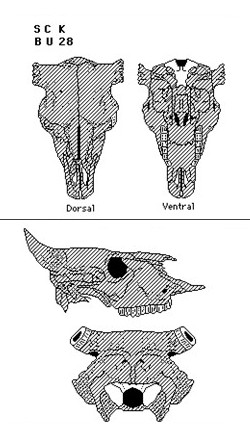
BU 28
SC K
Unit consists of both occipital condyles and the basilar part of occipital intact and completely detached from the rest of the skull.
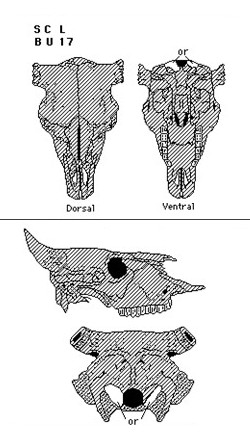
BU 17
SC L
Consists of complete or fragmentary portion of one of the occipital condyles - either left or right.
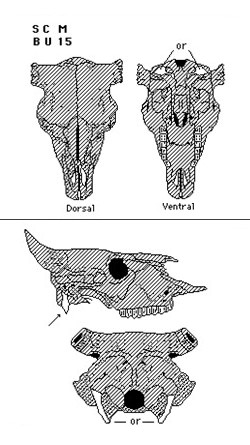
BU 15
SC M
All or most of paramastoid process. May be articulated to small portion of occipital.
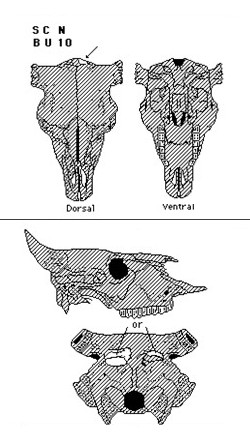
BU 10
SC N
Small to medium sized fragment of occipital distinguishable by the presence of linea nuchae superior and sometimes external occipital protuberance. Frequently indicates minimum number of skulls represented by this unit. For Oldman project, frequency indicates number of pieces only.
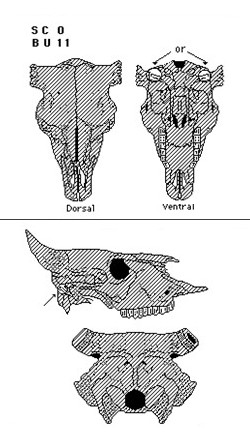
BU 11
SC O
Complete or portion of internal and external auditory meatii. Frequency indicates minimum number of meatii represented.
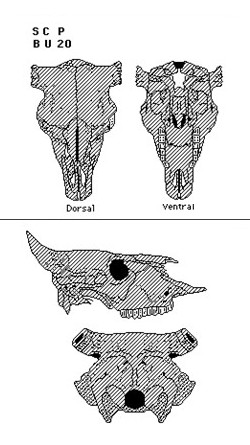
BU 20
SC P
Small to large fragment of basilar occipital with occipital condyles removed. Frequency indicates minimum number of crania. Similar to BU 28 and BU 33.
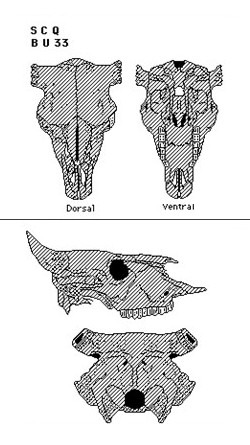
BU 33
SC Q
Complete basisphenoid detached or disarticulated from rest of skull. (AL)
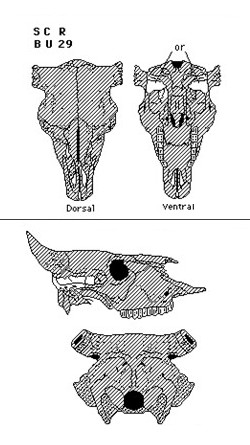
BU 29
SC R
All or major portion of temporal. Includes temporal crest and squamous portion of the temporal. May or may not include temporal condyle, zygomatic process of temporal and external auditory meatus.
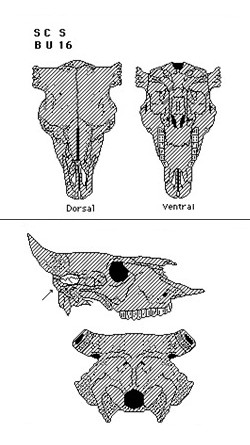
BU 16
SC S
Medium to small sized cranial fragment identifiable by presence of parietal temporal suture.
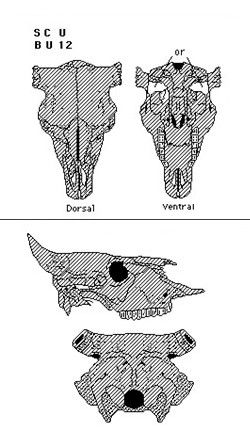
BU 13
SC T
Consists of essentially complete zygomatic process of temporal and immediately adjacent portion of temporal condyle.
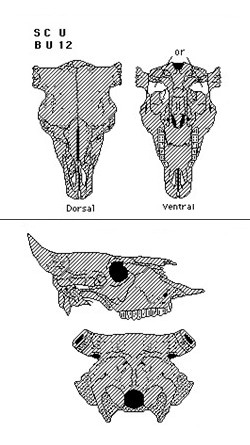
BU 12
SC U
Consists of temporal condyle. The zygomatic process of the temporal is absent. May or may not include small portion(s) of frontal and/or parietal articulated to it.
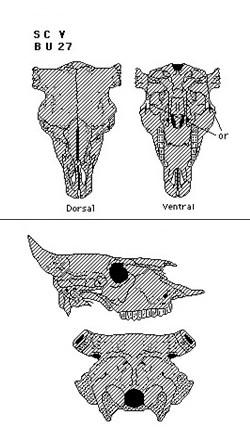
BU 27
SC V
All or major portion of zygomatic process of malar bone.
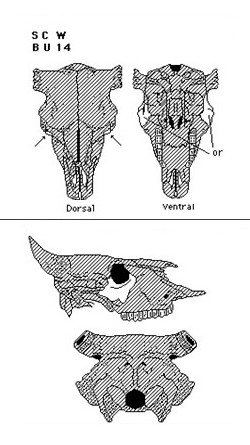
BU 14
SC W
All or major portion of malar bone. Zygomatic and temporal processes of malar usually both are absent or, occasionally, one present. Similar to BU 40.
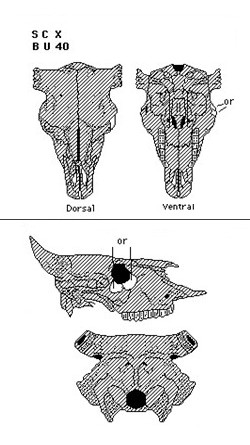
BU 40
SC X
Fragment of malar portion of orbit. Similar to BU 14. (KK)
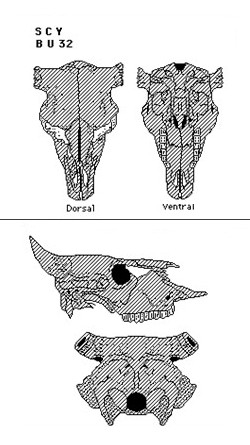
BU 32
SC Y
Complete lacrimal detached from rest of skull. Similar to BU 19. (AL)
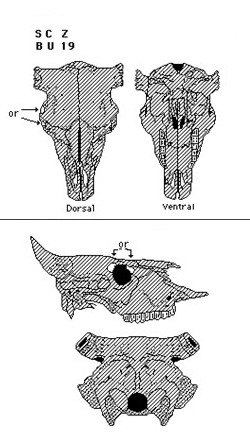
BU 19
SC Z
Portion of margin above either orbit (orbital portion) of temporal or lacrimal. Frequency indicates number of pieces from this region and not number of crania represented. Similar to BU 32.
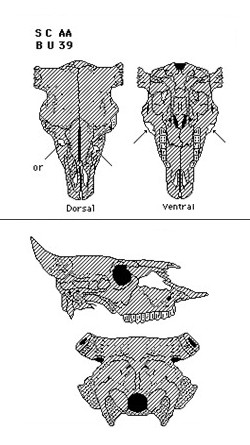
BU 39
SC AA
Large to small fragment of upper portion of maxilla lacking tooth row and palatine process. Suture and limited portion of adjoining lacrimal and/or molar may be represented. (KK)
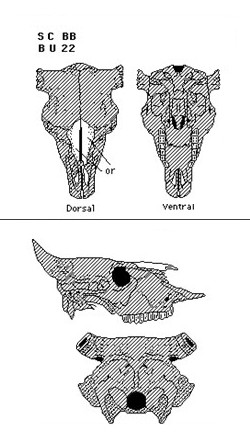
BU 22
SC BB
Complete left or right nasal disarticulated from rest of skull.
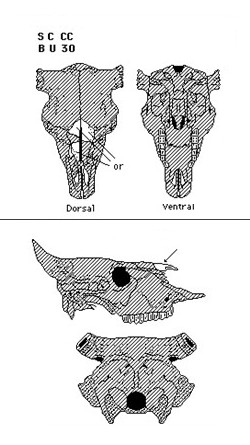
BU 30
SC CC
Fragment of nasal. Frequency indicates minimum number of elements represented. For Oldman project, frequency indicates number of pieces only.
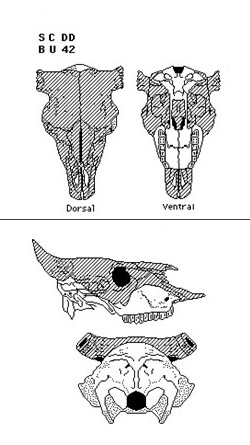
BU 42
SC DD
Unit consists of occipital, including condyles, basilar portion, supraoccipital, paramastoid processes, internal and external auditory meatus, parietal, sections of the palatine, and socketed sections of teeth from both maxilla. Similar to BU 8 and BU 28.
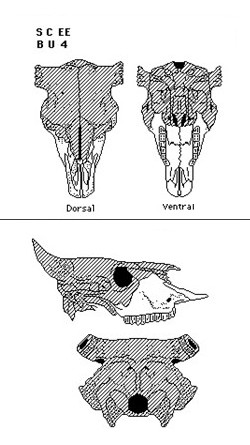
BU 4
SC EE
Consists of essentially complete and articulated left and right maxillae and premaxillae. Anterior portions of both palatines also present. A pair of BU 2 articulated along the palatine. Similar to BU 38.
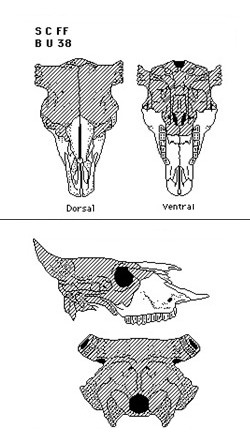
BU 38
SC FF
Large portion of anterior part of skull including both nasals, at least one premaxilla, major portion of both maxillas, some of the palatine. Similar to BU 4. (TH)
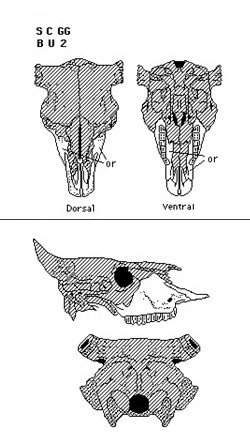
BU 2
SC GG
Essentially complete left or right maxilla and articulated premaxilla. Usually all or much of the palatine process of the maxilla and premaxilla is absent. Extreme margins may be absent.
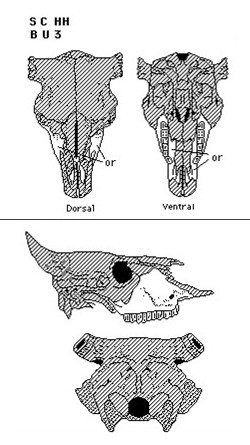
BU 3
SC HH
Same as BU 2 except that the premaxilla is absent. BU 3 often consists of only a complete row of sockets cheek teeth with the other margins of the maxilla absent.
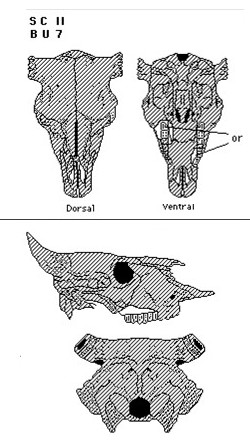
BU 7
SC II
Fragmentary section of maxilla consisting of a section, but not all of the socketed cheek teeth. Frequency indicates minimum number of elements represented.
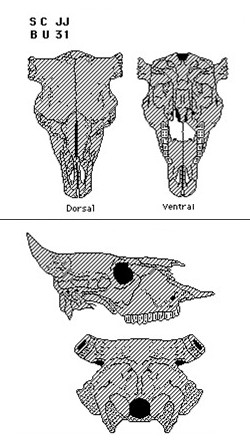
BU 31
SC JJ
All or part of horizontal portion of palatine. Usually distinguished by characteristic shape of posterior margin. May or may not be articulated to portion of opposite palatine. Frequency indicates minimum number of crania represented. Fragments of two palatine articulated or disarticulated but possibly from one crania are recorded as having a frequency of one.
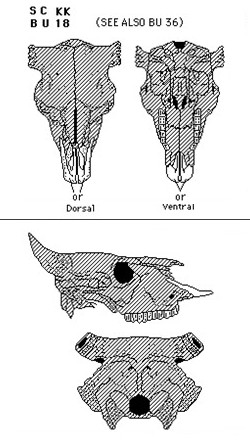
BU 18
SC KK
Single essentially complete disarticulated premaxilla. All or most of body, nasal and palatine processes present.
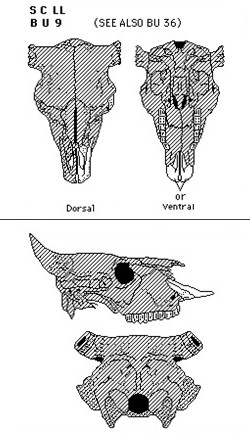
BU 9
SC LL
Consists of body and nasal process of premaxilla articulated to small portion of extreme anterior part of maxilla. Similar to BU 23 and BU 36.
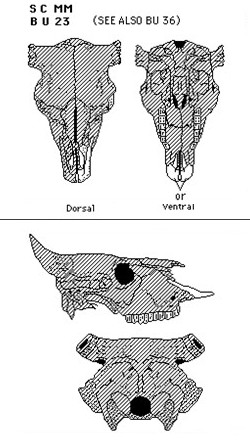
BU 23
SC MM
Body and nasal process or premaxilla. Palatine process absent. Includes none of maxilla. Similar to BU 9 and BU 36.
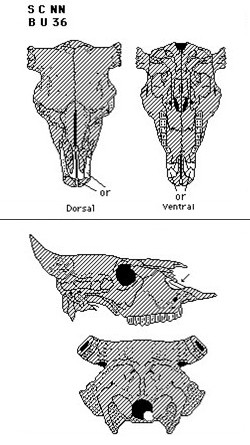
BU 36
SC NN
Small to large fragments consisting of portion of nasal process of premaxilla and small articulated fragment of maxilla. Body and palatine process absent. Similar to BU 9 and BU 23. (DS)
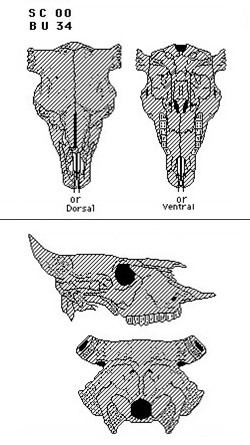
BU 34
SC OO
All or most of palatine process detached from rest of premaxilla. (AS)
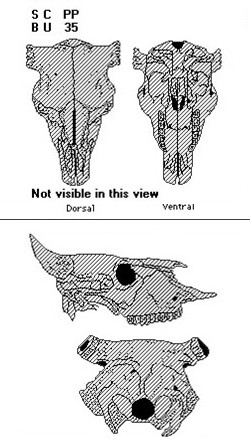
BU 35
SC PP
Skull fragment identified by bone shape and density; characteristic of internal skull. (SB)
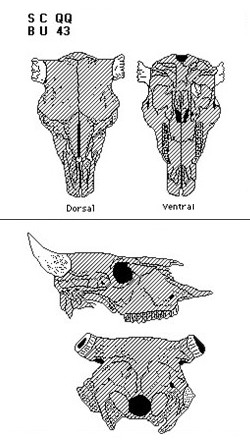
BU 43
SC QQ
Large portion of the horn and attachment to the skull. (SB)
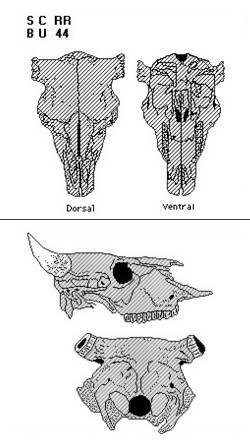
BU 44
SC RR
Small to medium portion of the horn. (SB)
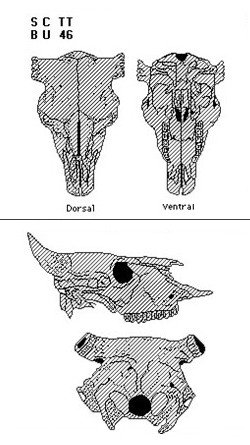
BU 46
SC TT
Fragment of the auditory meatus separated from the temporal lobe. (SB).
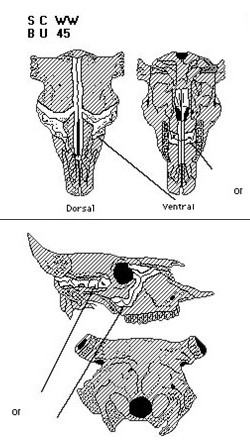
BU 45
SC WW
Section of sutures but undetermined as to which. (SB)